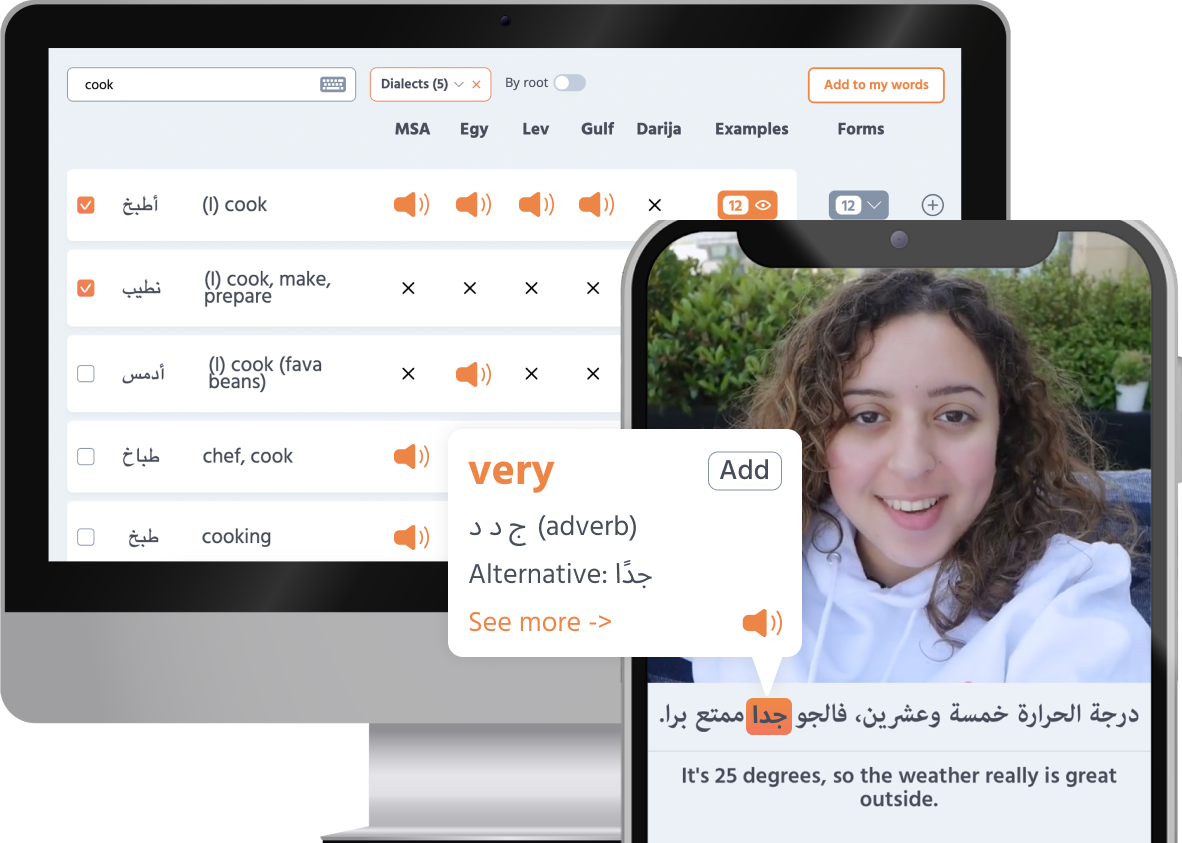If you’re learning Egyptian Arabic food vocabulary is a tasty way to improve your language skills while immersing in the culture. Let’s get into the essential phrases, cultural tips, and fun expressions for your next Egyptian meal .
Egyptian dining culture: Food is life In Egypt, food isn’t just about eating—it’s about sharing, connecting, and showing love. Whether you’re being invited to someone’s home or to a restaurant, expect to be treated with generosity, hospitality , and plenty of كمل أكلك
(finish your meal) or خد دوق الحتة دي
(try this bite).
Meals in Egypt: Breakfast, lunch, and dinner Egyptians take pride in their meals, which are often big, tasty, and traditional. Let’s get into the daily meals and their most popular dishes.
Breakfast الفطار
: A big start to the day Breakfast in Egypt is often a shared experience with dishes that are simple yet filling:
فول
(Beans): Fava beans slow-cooked and mashed, served with زيت زتون
(olive oil), لمون
(lemon), and كمون
(cumin).طعمية
(Falafel): Egyptian falafel made from crushed fava beans, deep-fried to golden brown.بطاطس
(Potatoes): Fried or mashed potatoes with spices for a comforting start.بتنجان مخلل
(Pickled Eggplant): Eggplant marinated with خل
(vinegar), توم
(garlic), and شطة
(chili) for a tangy side.بابا غنوج
(Baba Ghanoush): Roasted بتنجان
(eggplant) dip mixed with طحينة
(tahini), lemon, and garlic.جبنة
(Cheese): Whether it’s جبنة رومي
(rumi cheese), جبنة فيتا
(feta cheese), جبنة اسطنبولي
(istanbuli cheese), جبنة براميلي
(baramili cheese), or جبنة قريش
(cottage cheese).بيض
(Eggs): It is usually prepared in many ways: boiled, scrambled, or omelet.عيش بلدي
(Baladi Bread): Egyptian flatbread served with every breakfast dish.
Canva Pro image – used under commercial license. All these dishes are part of the traditional Egyptian breakfast, especially on Friday, since it’s the weekly day off. Check out the video below to see how an Egyptian family shares their Friday breakfast.
Learn key Egyptian breakfast phrases and customs in this real-world video on Playaling—don’t miss it! Lunch الغدا
: The main course Canva Pro image – used under commercial license. Lunch is the biggest and most important meal of the day, often shared with family:
كشري
(Koshari): A street food favorite of رز
(rice), عدس
(lentils), مكرونة
(pasta), and tangy tomato sauce, topped with حمص
(chickpeas) and بصل محمر
(crispy onions).محشي
(Mahshi): Vegetables like كوسة
(zucchini), بتنجان
(eggplant), كرنب
(cabbage leaves) or ورق عنب
(grape leaves) stuffed with rice and أعشاب
(herbs).رز بالشعرية
(Rice with vermicelli): Fluffy rice cooked with golden-brown fried vermicelli noodle pieces.مكرونة
(Pasta): Pasta with tomato sauce or بشاميل
(béchamel).طاجن بامية
(Okra casserole): Tomato stew with okra, often served with rice.ملوخية
(Molokhia): Green soup made with jute leaves, served with رز
(rice) and فراخ
(chicken) or أرانب
(rabbit).فراخ مشوية
(Grilled chicken): Spiced chicken grilled to perfection.حمام محشي
(Stuffed pigeons): Pigeons stuffed with rice or فريك
(farik) and fried in زبدة
(butter) or سمنة
(ghee).مسقعة
(Moussaka): A mix of eggplant, صلصة طماطم
(tomato sauce), and sometimes لحمة مفرومة
(ground meat).كفتة
(Kofta): Minced meat mixed with spices, shaped into skewers, and grilled.كباب
(Kebab): Tender pieces of grilled ضاني
(lamb) or beef, a favorite at celebrations.طرب
(Tarb): Minced meat wrapped in منديل
(thin layer of lamb fat) and grilled for a smoky flavor.فتة
(Fatta): A layered dish of rice, bread, and meat, topped with a garlicky tomato sauce.حواوشي
(Hawawshi): A loaf of Egyptian baladi bread stuffed with spiced minced meat and grilled for a crispy texture.كوارع
(Cow feet): Slow-cooked cow feet, considered a delicacy, often served with bread.ممبار
(Stuffed Intestines): Thoroughly-cleaned sheep or cow intestines stuffed with a mixture of rice, herbs, and spices.سلطة خضرة
(Green salad): Fresh veggies with lemon and olive oil dressing.
Through this clip from an Egyptian film, you’ll hear most of the lunch dishes mentioned. Dinner العشا
: A light meal Dinner in Egypt is typically lighter than lunch, usually simple and quick dishes:
جبنة بيضا وزتون
(White cheese and olives): A classic combo with bread.بيض
(Eggs): Scrambled or fried eggs paired with baladi bread.زبادي
(Yogurt): Plain yogurt with a drizzle of عسل
(honey).بطاطس محمرة
(Fried potatoes): Quick and easy.فواكه
(Fruits): sugary and refreshing, like: تفاح
(apples), برتقان
(oranges), موز
(bananas), كمترى
(pears), عنب
(grapes), كنتالوب
(cantaloupe), and بطيخ
(watermelon).
An Egyptian guy shows us how to make a salad . Each meal in Egypt is a story of tradition, hospitality, and a love for bold flavors. From breakfast to lunch to dinner, Egyptian cuisine is as diverse as its culture.
Essential restaurant vocabulary Ordering food like a local When you eat out, knowing how to order food in Egyptian Arabic can save you from awkward moments and open doors to more authentic experiences. Here are the essentials:
عندك منيو؟
– Do you have a menu?ممكن المنيو لو سمحت؟
– Can I have the menu, please?أنا عايز أطلب
– I’d like to order…إيه الأكلات اللي تنصح بيها؟
– What do you recommend?الأكل ده حراق؟
– Is this spicy?ممكن الحساب لو سمحت؟
– Can I have the bill, please?الفاتورة لو سمحت
– The bill, please.الحمام فين؟
– Where is the restroom?
Egyptian food and drinks vocabulary English Arabic Food أكل
Bread عيش
Rice رز
Pasta مكرونة
Veggies خضار
Chicken فراخ
Meat لحمة
Grilled مشوي
Fried مقلي
or محمر
Drinks مشروبات
مشاريب
Water مية
Tea شاي
Coffee قهوة
Cold soda drink حاجة ساقعة
Juice عصير
Casserole طاجن
Dish طبق
Spoon معلقة
Fork شوكة
Knife سكينة
Napkin منديل
Glass كوباية
Cup فنجان
Bottle إزازة
Appetizers مقبلات
Salads سلطات
Dessert الحلو
For a fun video that covers many of these foods, watch the video below.
Don’t miss the full video . Home-cooked meals: Words to share Phrases for the Egyptian kitchen Home-cooked meals are where the real Egyptian food magic happens. If you’re lucky enough to join a family dinner, you’ll need these words:
عزومة
– Feast or invitationمطبخ
– Kitchenطبخ
– Cookingمكونات
– Ingredientsبهارات
– Spices
Compliments and polite expressions
!الأكل جامد أوي
– The food is amazing!تسلم إيدك
(to a male), تسلم إيدك
(to a female) – Bless your hands (a compliment to the cook).سفرة دايمة
– May your table always be abundant.البيت بيتك
(to a male), البيت بيتك
(to a female) – Make yourself at home.بالهنا والشفا
or بألف هنا
– Bon appétit.الحمد لله
– Thank God (used to express fullness).اتفضل
(to a male), اتفضلي
(to a female) or مد إيدك
(to a male), مدي إيدك
(to a female) – Here you go/grab a bite.أنا شبعت، شكرًا
– I am full, thanks.
Preferences, allergies, and restrictions When it comes to dietary needs, Egyptians are generally accommodating. But it’s good to know these phrases:
مابحبش التوم
(I don’t like garlic.)أنا عندي حساسية من اللبن
(I’m allergic to milk.)فيه أكل نباتي؟
(Do you have vegetarian food?)
Describing your food: Food adjectives in Egyptian Arabic Adjectives make your descriptions more vivid and your orders more precise:
حراق
or حامي
or مشطشط
(Spicy), because why not? مسكر
or حلو
(Sweet), for those with a sweet tooth.مزز
(Sour), perfect for describing pickles or certain salads.مملح
(Salty) when you like that extra flavor, while دلع
means (needs more salt). دسم
or تقيل
(Greasy), for those dishes that are deliciously indulgent.
Proverbs and idioms about food Egyptian Arabic is full of expressions, and many of them are food-related:
عيش وملح
(bread and salt), meaning a bond created through eating together.لقمة هنية تكفي مية
(a gracious bite is enough for a hundred), meaning that food served with love and generosity, no matter how small, can satisfy many people. This reflects the value Egyptians put on hospitality and the emotional connection over meals.ياكل عيش
(literally “to eat bread” but means to make a living), although among the young generation it refers to minding one’s own business.
Egyptian dining etiquette: Do’s and don’ts
Don’t start eating before everyone’s served. Wait for the host to signal.Say بسم الله
before you eat. This means (in the name of God) and is a habit.Use your right hand to eat. It’s polite and traditional.Egyptians often eat with their hands , especially with bread-based dishes. Don’t be afraid to ask how to do it!Meals are usually communal , so dishes are shared. Take what you need, but be mindful of others.When dining in a group, it’s common for one person to pay the bill, but offering to contribute is polite .
Tell the chef you like the food. Say: تسلم ايديك
(for male), and تسلم ايديكي
(for female)
FAQs about learning Egyptian Arabic through food What are the most important Egyptian Arabic words for food?
Key terms include مية
(water), عيش
(bread), لحمة
(meat), and أكل
(food).
How do I order food in Egyptian Arabic?
Start with عندك منيو؟
(do you have a menu?), then use عايز أطلب الأكل
(I want to order food) to place your order.
What are some cultural tips for dining in Egypt?
Always accept food when offered, wait for the host’s signal to eat, and use your right hand for eating.
Are there specific phrases for food allergies?
Yes, for example, أنا عندي حساسية من اللبن
(I’m allergic to milk.)
Can I use Egyptian Arabic phrases in other Arabic-speaking countries?
While Egyptian Arabic is widely understood, local dialects may vary. For example the Egyptian word for milk is لبن
and for yoghurt is زبادي
, however, in Levantine , the word لبن
means yoghurt while milk is called حليب
. It’s often better to stick to simple phrases when in doubt.
Oh, and by the way… If learning Egyptian Arabic at your own pace, with fun, real-world videos sounds like your style, then Playaling could be exactly what you’re looking for!
With Playaling, you’ll dive into Arabic just as it’s spoken in Egypt. Our diverse range of videos has it all—from everyday conversations and cultural moments to music videos, TV and movie clips, influencer content, news broadcasts, and inspiring talks.
Our interactive captions let you tap any word for instant translations, context, and audio. So, real Egyptian content becomes accessible with just a click. Miss something? No problem—rewind and listen as often as you need, or hover over subtitles for quick definitions.
Spot a word you want to learn? Save it to your personalized word set, or dive into curated sets for focused practice and easy review.
Interactive exercises let you dive in and practice what you’ve learned.
Need to look something up? The Audio Dictionary has you covered with clear human pronunciations and real world examples.
It’s a learning experience that keeps you engaged, bringing authentic, real-world Arabic closer to you every step of the way.









